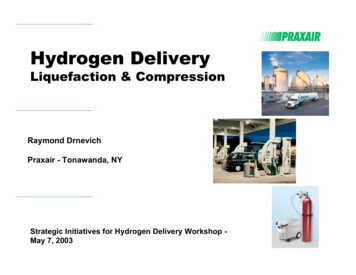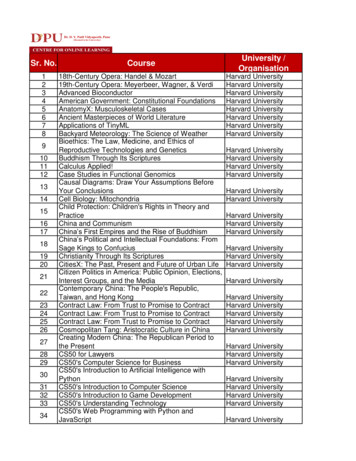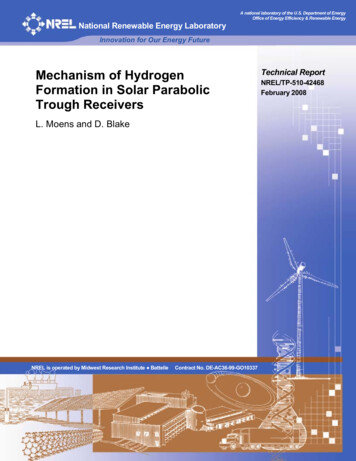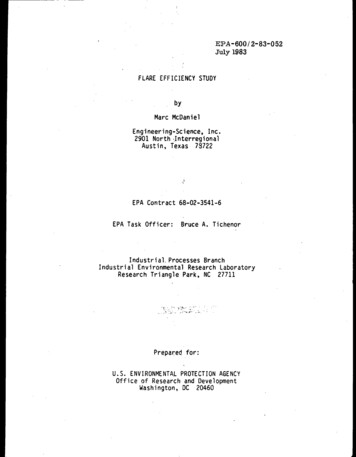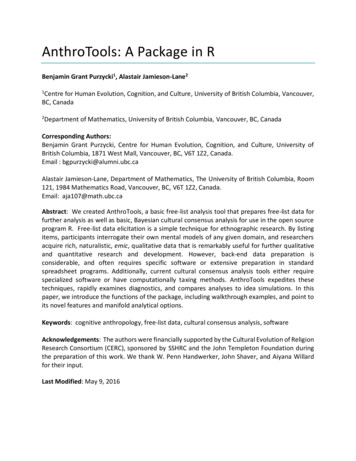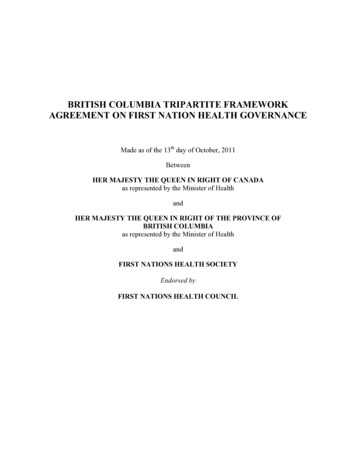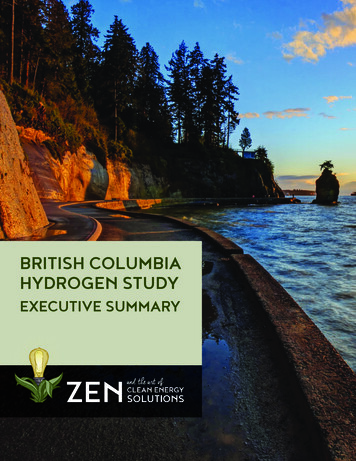
Transcription
BRITISH COLUMBIAHYDROGEN STUDYEXECUTIVE SUMMARY
ACKNOWLEDGEMENTSThe BC Hydrogen Study was conducted by Zen and the Art of Clean Energy Solutions and project partners theInstitute for Breakthrough Energy and Emission Technologies and G&S Budd Consulting Services. Work on thestudy ran from February 2019 to June 2019.The project team would like to thank the many individuals and organizations that provided input to the studythrough participation in workshops, surveys, and individual interviews. The team would also like to thank theBC Ministry of Energy, Mines and Petroleum Resources, BC Bioenergy Network, and FortisBC for support andguidance throughout the study.Project TeamProject SponsorsBCBN Hydrogen Study, Final Reportii
EXECUTIVE SUMMARYWhy Hydrogen in BC?Deployment of hydrogen in British Columbia (BC) will be required for the Province to meet 2030 and 2050decarbonization goals and emissions reduction commitments. End use energy demand in BC was 1,165petajoules (PJ) in 2016, with 68% of demand met through refined petroleum products and natural gas. Directelectrification and increased supply of renewable natural gas will not be able to displace all this energy totransition the Province to lower carbon and ultimately renewable energy sources. Hydrogen will play a criticalrole, particularly in energy intensive applications that are most reliant on fossil fuels today such as long-rangetransportation and heating.Hydrogen is a versatile energy carrier that can be made from a range of feedstocks that are abundant in ourProvince, and it has the advantage of being carbon free at the point of use. BC has a distinct comparativeadvantage because of its clean electricity and low-cost natural gas resources, both of which can be leveraged toproduce hydrogen. Hydrogen can be: Blended with BC’s rich natural gas reserves to create a cleaner burning fuel and increase the renewablecontent of the gas delivered through our extensive natural gas infrastructure; Used directly in fuel cells to produce zero emission electricity in electric vehicles, stationary power systems,and off-road industrial vehicles; and Utilized as a feedstock in industrial applications, including to produce renewable synthetic liquid fuels thatallow existing combustion engines to be used in a cleaner and more sustainable way.Use of hydrogen in BC is in the nascent stages, while the pace of worldwide deployment is clearly accelerating.For BC to realize 2030 emissions reductions goals as set out in the CleanBC plan, it is important for governmentto work with industry now to establish supply and infrastructure necessary to stimulate adoption in the Province.Export opportunities can help to bring international investment to the development of our hydrogen energysystems and provide strong revenue generation potential.Building of a vibrant and robust hydrogen economy in the Province will result in: Decarbonization of hard-to-abate sectors of the economy such as heating and cooling, long-rangetransportation applications, and energy intensive industries; Economic growth and job creation through the development of BC’s hydrogen supply chain andinfrastructure, and supply to emerging export markets; and Leveraging BC’s natural gas reserves and infrastructure to meet emissions reductions goals in the mid-termwhile transitioning to renewable energy sources in the long-term.Large-scale deployment of hydrogen in BC can close the gap in current plans to balance both emissions reductionand optimal utilization of BC’s natural resources and infrastructure assets. It will also benefit the Province’sworld-class hydrogen and fuel cell sector which is increasingly facing pressures to develop new intellectualproperty (IP) abroad, in regions where governments support both deployment and development of hydrogenand fuel cell technologies.BCBN Hydrogen Study, Final Reportiii
Decarbonization of Economic SectorsCleanBC is the Government of British Columbia’s plan for achieving its greenhouse gas (GHG) emissionsreductions commitments from the May 2018 Climate Change Accountability Act, formerly titled Greenhouse GasReduction Targets (GGRT) Act.To meet its commitments, provincialemissions will have to fall 40% fromthe 2007 baseline by 2030 and 80% by2050. Hydrogen is needed to meet thosedecarbonization objectives, with studyfindings demonstrating that hydrogencan contribute up to 31% of the 2050carbon reduction target, at 15.6 MtCO₂e/year reductions. The benefits ofhydrogen will be strongest in the 2030 –2050 timeframe, after other high-yieldopportunities outlined in the CleanBCplan have been implemented andexhausted. In this period, hydrogen canreduce emissions by 13.7 Mt CO₂e, whichrepresents 54% of the Province’s goalduring that timeframe.The opportunities where the greatestdecarbonization impacts can be realized are: 1) through injection of low carbon hydrogen into the natural gasgrid, which will have benefits in the built environment, transportation, and industry economic sectors in theProvince; 2) through using low carbon hydrogen directly as a transportation fuel; and 3) through the productionof low carbon synthetic fuels that can be used as drop in replacement for current combustion engines and are animportant enabler in meeting the Renewable and Low Carbon Fuel Requirements Regulation in BC.The relative benefits in these applications will shift over time. In the near-term, the easiest and lowest costway to use hydrogen which will have the highest emission reduction potential in the Province is to inject it intothe natural gas grid, and directly reduce emissions by utilizing the lower carbon hydrogen/natural gas blend.Ultimately directly using hydrogen as a transportation fuel will dominate in emissions reduction potential.The deployment of both battery electric and fuel cell electric vehicles (FCEVs) is critical to reducing emissionsin BC. The higher range and faster refueling times of FCEVs will lead to meaningful market share in theProvince, particularly in larger passenger vehicles and in medium and heavy-duty vans, buses, and trucks.Utilizing hydrogen directly as a transportation fuel offers the greatest advantages for emissions reduction, aselectrochemical conversion of hydrogen in fuel cells is twice as efficient as combustion. Regulation and financialsupport for infrastructure build out will be critical to achieving the adoption potential of FCEVs. As the transitionto FCEVs is evolving, hydrogen can offer emissions reduction benefits in transportation applications throughenabling higher use of renewable natural gas (RNG), in co-combustion retrofit engines, and as a low carbonfeedstock for synthetic fuels.BCBN Hydrogen Study, Final Reportiv
2030 GHG Reduction Opportunities1.9 Mt CO₂e/year2050 GHG Reduction Opportunities15.6 Mt CO₂e/yearIn these graphs, ‘Natural Gas’ includes all end use applications that would benefit from the lower carbon H₂/NG blend, including heating in the built environment and industry, and transportation applications runningon compressed natural gas (CNG). ‘Transportation’ refers to applications where pure hydrogen is used as atransportation fuel, either in fuel cell electric vehicles or hydrogen/diesel co-combustion engines.Economic Growth and Job CreationSince Geoffrey Ballard first set up shop in North Vancouver in 1979, Canada’s hydrogen and fuel cell sector hasbeen recognized as a global leader, with BC hosting Canada’s largest industry cluster. BC has pioneered newtechnologies and industry expertise in areas such as hydrogen production and processing, fuel cell stack andsystem development, components and systems testing and test infrastructure development, technology researchand development (R&D) and commercialization, and standards development. BC is also home to world classacademic institutions with specialized programs and R&D supporting the clean tech sector. Local deployment ofhydrogen technology will help to maintain a healthy economic cluster in the Province, and will help to developtechnical expertise, job opportunities and IP, and will also contribute to continued growth of the sector byensuring BC maintains a strong competitive advantage.BC’s economy is heavily dependent on the extraction, consumption, and export of natural resources,and hydrogen fits as a value-added future export resource that can support both local and internationaldecarbonization efforts. Hydrogen is expected to become increasingly important in the world’s energy systems ascountries around the world develop roadmaps to achieve decarbonization goals and to improve local air quality.BC’s coastal access and relative proximity to leading markets such as California, Japan, China and South Koreaposition BC to become an exporter of clean hydrogen. By 2050, demand in those target regions is projected toreach 100 million tonnes/year under moderate forecast assumptions, with significant upside potential. If BCwere to capture 5% market share in those regions, the export market could be 15 billion annually. Internationalinvestment for large-scale hydrogen production would benefit local markets while generating significant revenueand should be considered as a significant opportunity for the Province.The Intergovernmental Panel on Climate Change (IPCC) estimates that USD 2.4 trillion will need to be investedthrough 2035 in clean technology deployments.1 A portion of that investment will be made in the hydrogensector, and BC can benefit from that through its leadership in the development and deployment of hydrogentechnologies. BC is well positioned to reinvigorate its leadership position in innovation and venture creation.Build-out in the Province will benefit professional, trades, and manufacturing employment.1IPCC. (2018). Special Report: Global Warming of 1.5 C. Retrieved from https://www.ipcc.ch/sr15/BCBN Hydrogen Study, Final Reportv
Low Carbon Use of Natural Gas Reserves and InfrastructureBC is fortunate to have an abundance of clean, renewablehydroelectric power. In 2016 electricity supplied 19% of theProvince’s end use energy requirements. Electrification is a majortheme in CleanBC to meet the Province’s emissions reductions goals.While electrification will play an important role, it has limitationsin generation capacity and transmission and distribution. Someapplications are better served by gas as an energy carrier, suchas high-grade heat production and long-range transportation. BChas abundant low-cost natural gas reserves that will play a role inmeeting energy needs of the Province far out into the future. TheNational Energy Board (NEB) forecast shows increasing demand forboth natural gas and refined petroleum products in BC out to 2040.This is at odds with the Province’s emissions reduction goals unlesswe can find ways to decarbonize those energy sources. Hydrogencan play a key role in this through the decarbonization of natural gasat the source of extraction, and as a renewable feedstock for refinedpetroleum products and lower carbon intensity synthetic fuels toreplace conventional refined petroleum products.2016 BC End Use Energy Demand2The natural gas infrastructure is a strategic asset for BC. Repurposing that asset for both the transportationand storage of hydrogen presents a cost-effective pathway for the large-scale deployment of hydrogen inthe Province. The existing natural gas infrastructure can act as storage for low carbon hydrogen, initially as ahydrogen/natural gas blend and transitioning to 100% hydrogen in some regions of the Province over the longerterm. Hydrogen produced via electrolysis can also foster greater integration of our electricity and gas energysystem, optimizing the Province’s overall energy systems to achieve optimal efficiency and economic return oncritical infrastructure assets.Hydrogen Production Pathways in BCHydrogen can be produced via different pathways using a range of feedstocks. Hydrogen can be made viarenewable and fossil fuel resources and is a by-product of some industrial processes. In this study, only ‘GreenHydrogen’ produced from clean and renewable electricity, ’Blue Hydrogen’ produced from natural gas or biomasscoupled with carbon capture and storage (CCS), and low carbon intensity (CI) industrial by-product hydrogen areconsidered.2Canada National Energy Board (2017). Canada’s Energy Future 2018: Energy Supply and Demand Projections to 2040.Retrieved from emplateCulture en-CABCBN Hydrogen Study, Final Reportvi
Hydrogen produced at scale from natural gas offers the lowest cost source of low carbon intensity hydrogenwhen coupled with carbon capture and storage technology. BC has substantial natural gas reserves in theNortheast of the Province, estimated at 525 trillion cubic feet and sufficient to meet 315 years of BC natural gasdemand at current levels. The Province also has depleted gas reservoirs and saline aquifers that enable largevolumes of CO₂ sequestration. Steam methane reforming (SMR) coupled with carbon capture and storage at thepoint of extraction is a mature commercial process, whereas pyrolysis with carbon black as a byproduct showsstrong potential but is at lower technology readiness level (TRL).Renewable sources of hydrogen in the Province are currently more expensive than fossil pathways. Productionof hydrogen via electrolysis enables a distributed model of hydrogen production that is inherently scalable.While offering many advantages, the electrolysis pathway is currently the most expensive for at-scale hydrogenproduction in the Province. Flexible, low-cost electricity rates are essential to promoting the growth andadoption of Green Hydrogen.There is an immediate urgency to decarbonize BC’s energy supply across all industry sectors, and low carbonintensity hydrogen from fossil fuels is seen as a key enabler to cost effective deployment of hydrogen in theintermediate period. The Province needs policy to drive adoption of multiple energy pathways to ensure bothdecarbonization and sustainability goals are met. Our policies should set BC as the global leader in hydrogenproduction with a clear understanding of how their inherent cost structure will drive market adoption ofthe lower cost natural gas sourced hydrogen to the more expensive fully renewable hydrogen as the finitehydrocarbon sources are depleted over time.BCBN Hydrogen Study, Final Reportvii
Vision for 2050investment, hydrogen can play a major role in the Province by 2050.BCBN Hydrogen Study, Final Reportviii
RecommendationsThe report outlines a comprehensive list of 38 instrument and policy recommendations to support developmentof a vibrant hydrogen economy in BC.The top ten recommendation themes for the 2020 – 2025 timeframe are to:1. Identify and communicate hydrogen as priority sector for the Province.2. Prioritize development of large-scale, low carbon intensity hydrogen supply infrastructure and strategichydrogen liquefaction and distribution assets in the Province.3. Adopt policy that specifies the carbon intensity of hydrogen, rather than limiting to renewable only. Thisincludes updating the definition of renewable natural gas in BC’s Greenhouse Gas Reduction Regulation toinclude low carbon intensity hydrogen.4. Set longer-term objectives for transition to renewable hydrogen supplies through establishing tieredthresholds of required renewable content over time.5. Develop flexible, lower cost electricity rate schedule to encourage production of Green Hydrogen.6. Support lighthouse projects that will demonstrate the potential of hydrogen in critical end use applications.7. Adopt recommended policies and regulatory framework for light and heavy-duty FCEVs and support the buildout of hydrogen refueling infrastructure.8. Support research, development and deployment in the Province to ensure the local hydrogen clustermaintains competitive global advantages and remains an important economic sector within the Province.9. Support initiatives related to developing an export market for hydrogen, particularly those that can leverageinternational investment to develop local supply of hydrogen.10. Prioritize a strategic investment fund to support the above recommendations.Recommended Investment, 2020-2025Government investment is needed to establish a robust hydrogen economy in BC. That investment will providethe necessary infrastructure and sector support to allow industry to establish a foundation from which togrow commercial deployments. Government investment will yield necessary decarbonization benefits for theProvince, economic growth potential, and long-term diversity and security of our energy systems.Our analysis recommends a total spend from the Province in the order of 176,000,000 over the next five years,which is approximately 35,200,000 per year. This funding would be focused primarily on supporting lighthouseprojects and studies, funding critical infrastructure development, providing subsidies for the rollout of lightduty FCEVs, and supporting the sector through establishing dedicated R&D funding. It is anticipated that thisProvincial funding would be leveraged with Federal and Industry match funding, thereby amplifying the benefitsof this investment in the Province.BCBN Hydrogen Study, Final Reportix
Hydrogen in BC – A Phased ApproachFor hydrogen to play a critical role in BC’s energy systems in the mid and long-term, it is important to set goalsand start developing supporting infrastructure and policies now. Over the next 5 years, the focus needs to be onestablishing supply and distribution infrastructure for hydrogen, with lighthouse projects supported to initiatethe rollout of end use applications in the Province. The following schematic summarizes the phases of hydrogenrollout and opportunities in the various applications over time.BCBN Hydrogen Study, Final Reportx
EXECUTIVE SUMMARY. BCBN yrogen ty in eort ii The BC Hydrogen Study was conducted by Zen and the Art of Clean Energy Solutions and project partners the . allow existing combustion engines to be used in a cleaner and more sustainable way. Use of hydrogen in BC is in the nascent stag
